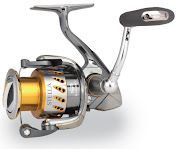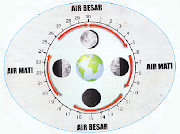Thursday, February 10, 2011
Longest Lived Fish - Rougheye Rockfish
Most of the fishing for this commercially-important species occurs between northern Washington State and the Bering Sea, although some fishing is done off Oregon and in the Kamchatka area. Bottom trawl and longline are the primary fishing methods used. The rougheyes are occasionally caught in recreational fisheries.
The rougheye is also identified by appearing pink, tan, or brownish with loose patches of brown or bronze when viewed underwater. A darker blotch usually appears on the rear of the operculum, and the posterior area of the lateral line is often pinkish in color. These fish are bright red or pink with black or gray patches after capture. These fish usually grow to 32 in. (80 cm), and have been reported as large as 38 in. (97 cm). Males and females are thought to be of similar lengths at any given age.
The rougheye's range extends from San Diego to the Aleutian Islands and Bering Sea to the Kamchatka Peninsula and Japan. They are found in depths of 25 meters and as deep as 2,830 meters. The rougheye live in water temperatures ranging from 0.3° up to 4.9° C. They are found near the sea floor around caves, crevices, and steeply sloped boulder fields surrounded by soft substrata. Their diet consists primarily of pandalid shrimp, while they also feed on crab and fish.
Source from: http://www.afsc.noaa.gov/rockfish-game/description/rougheye.htm
How to Increase Catch During Fishing
First and perhaps most important to putting together the puzzle is a good understanding of the individual species being pursued. Most game fish species are carnivores and will eat a wide variety of foods, but quite frequently they feed on other smaller fish. Fish are opportunistic feeders and will feed when hungry and food is readily available. However when full they may totally ignore the food source.
The quest to determine the best times to fish is not a recent project. For hundreds of years people recognized that there were certain times when fishes were more abundant. People who base their existence on the ocean or lakes have long understood that sun and moon influences help to determine the best times for fishing.
What is generally known and almost universally accepted is that fish are more active at certain times of the day, most noticeably at dawn and dusk. It is also generally agreed that many game species are more active during certain phases of the moon as well as when the moon is in certain positions in the sky each day. All of these influences have an individual effect that can be observed and in some instances measured.
What determines why one specific day is a better day to fish than another and why we are more likely to find fish feeding at certain times of the day? Virtually all wildlife repeats certain activities each and every day. All fish and animals must eat and rest to sustain life. The movement necessary to accomplish these basic needs is what provides all of us with the opportunity to catch more fish.
Our ability to understand how these solar and lunar influences affect feeding activity has made fishing more predictable. During each day the sun and moon exert their individual influence on each and every hour. Each hour and day will have a different combination of these influences. Understanding the affects of the sun and moon on wildlife is only one part of the complex puzzle that helps predict when fish are most active.
Solar Influence - the primary solar periods that are factored in Weather and Wildlife charts are dawn, dusk, midday and midnight. Each of these periods is determined based on the exact time of sunrise and sunset for that specific location and date. The sun has its greatest influence when it is at its zenith or most directly overhead. That point occurs around June 21st each year in the northern hemisphere while for the equinox in September.
Lunar Influence - the most obvious and measurable affects of the moon on the earth are seen with tides. The gravitational force of the moon is one of the primary influences in the rise and fall of tides. The periods of greatest lunar influence on wildlife are when the moon is most directly overhead and then again when it is opposite side of the earth. These two positions are usually referred to as “major or excellent" activity periods. Minor feeding times follow the major times by approximately 6 hours. The moon phase has also been shown to indicate certain heightened periods of activity.
Understanding the impact of weather on the individual species of fish you are pursuing as well as other factors including depth, water temperature and clarity are also important factors in your success. There is a great deal of information available on the Internet for people who want to learn about the anatomy, habits, diet, reproduction and many other facts about various game fish.
Thursday, February 18, 2010
Recreational Fishing - Sell the Fishing NOT the Fish..!
The popularity of recreational fishing has grown steadily over the past several decades. Pursuit of the social, psychological, and physical benefits of recreational fishing has created an industry focused on supplying the goods and services necessary to meet angler demand as well as ensuring satisfying recreational experiences.
How much does the regular anglers spend in a year? The expenditures of anglers have a significant economic impact, affecting local, state, and national economies. They sustain old jobs and create new ones. They support manufacturers, suppliers, and service industries. The total economic output of the recreational saltwater fishing industry is substantial and supports an extensive number of full and part-time jobs.
Recreational value by residents is measured by the total annual expenditures, estimated economic output, and estimated number of full-time jobs created. Total annual expenditures is the amount of money spent on a typical fishing trip (saltwater or freshwater) and the cost of replacing equipment. Estimated economic output is the total value of goods and services produced in an economy in order to satisfy a specified amount of final demand in a specified sector. The estimated number of jobs is the number of individuals employed in an economy per million dollars in final demand for a given sector.
People may realize that recreational fishing was important to economy, but how many really know just how important the recreational fishing is? To answer the question, we need to start collecting the statistics. The statistics collections for the recreational anglers value to the economic growth was long projected and calculated by some states in the
Anglers do what they do for the fishing, not the fish. The message is “SELL THE FISHING, NOT THE FISH”
Thursday, October 8, 2009
Learning Baitcasting Reel - First Overhead Cast
Hold the rod horizontally in front of you. The handles should be on top of the reel, that is, pointing UP if you're right-handed (using a right-handed reel). This is similar to the way you would hold a tennis racket and gives the widest possible range of movement to your wrist.
With your thumb applying pressure directly on the spool, unlock it, using whatever mechanism is used (thumb bar, pushbutton, etc.). The pressure of your thumb against the spool is what's preventing it from moving at this point.
Bring the rod up over your shoulder to approximately the
Now bring the rod forward as if you were trying to hammer a nail in a wall in front of you, but use a smooth motion; this is NOT the time for forceful movements! As the rod reaches the
While you are practicing (yes, you are going to need to practice with this reel), back off on the brake just a little at a time. Eventually you will get more comfortable with the new settings and you should be able to cast farther. Experiment with different settings with the brake and spool. The whole trick to using the baitcasting reel is the use of the thumb. Applying and releasing pressure to the spool with your thumb is the key to this system, and you must master it.
Throwing too hard will snag you up. Throw a moderate distance until you get used to it. As you get better at this, you will see your distance improve. Make sure it is your wrist that is doing the casting. To learn to do this take a small object similar to a pack of smokes, deck of cards, etc., and place it between your inner bicep and your side and practice casting without dropping the object. This will force you to use your wrist primarily and when you get better you can add different arm strokes to suit.
After you've practiced using the suggested adjustments and get a good feel of things, you will gradually be able to reduce the amount of tension and braking force, as you simultaneously "educate" your thumb.
Put your thumb on the line to hold it in place while you click the line release button. Cast the lure by releasing the thumb pressure, but keep the thumb barely touching the line (using your thumb for anything but very lightly feathering of the spool at any other point only cuts down on your distance and isn't the best way to maintain control over the cast; that's what brakes are for).
As the lure reaches its destination, apply more pressure with the thumb as a brake and to keep the line from spooling off into a bird's nest. It takes a lot of practice to get the right touch.
Finally, if you can master the basic cast, and achieve both control and comfort, then it truly becomes a matter of practice and more practice for distance, accuracy and versatility.
Learning Baitcasting Reel - Definitely Worth
Baitcasting reels are some of the most difficult types of reels to learn how to use. The expectation with these types of reels is that you have a clear understanding of the purpose of the cast and the relationship between the cast and control of the reel itself. You are expected to understand how different weights will affect your cast and the operation of the reel. If you do not have the proper skills necessary to use this type of reel it will be an exercise in frustration. Once you have mastered the skills of casting with an open faced model you can move onto using bait casting reels.
Choosing the right type of reel for you is by the most part based on your skill level and your knowledge of reels and how they work. It is all about whether or not you have the right skills for the reel. If you are honest with yourself and choose reels for your skill level, fishing will be a much greater experience for you in the long run.
The great thing about a baitcasting reel is the ability to cast a country mile. Additionally, when you get that heavy weight fish on the line, this reel gives you plenty of confidence to 'play' with the fish. Set the drag so that the fish can pull some line out when it runs, and you will have the time of your life...
The problem with baitcasting reels is backlash or bird's nest. This is a nightmare when you are first learning to use a baitcasting reel. In fact, if you are used to using another reel, don't go fishing without it until you have the baitcaster mastered. Take it even when you do have it mastered because even the pros backlash, and if it happens your new baitcasting reel will probably end up in the garbage with an eternal bird’s nest!!!! The main secret is thumb control. You control the output of the line with your thumb. Your high determination to use this fine piece of equipment, you will eventually get a feel for it.
Whenever a beginner asks for guide in learning how to use a baitcasting reel, most of the so called experts may say:
If we don’t know where to start, all we are doing is getting more and more frustrated. Trial and error may be okay for some people but not me. Making all the possible errors before we figure out the right way, is the worse way of learning. We need to find out the best possible ways of learning before we really start learning - Start at the very bottom of the learning curve and try to master only one thing at a time soon our progress is faster and with less aggravation along the way.
So, what is the best way to tackle these buggers? First, you'll want to make sure it's set up right.
Set-up 1: Don't Overspool
While you are learning the baitcasting reel, do not overspool. Adding too much line, at least until you get used to throwing it, will cause backlash. By adding less line to the reel, less line comes off with every rotation and it's easier to avoid backlashing, especially with mono which has a memory and will loosely coil up around the spool once tension is relieved.
Set-up 2: Make Sure To Get The Right Combo
The lighter the lure you are casting, the shorter the rod you need for the baitcasting reel. Using too long of a rod with a light weight lure will result in backlash.
Set-up 3: Adjust The Spool Tension - as tight as it will go
For now, tighten it to the point where you need to jiggle the rod slightly for the lure/weight to drop some, but without continuing all the way to the ground.This is tighter than usually recommended, but the goal at this point is CONTROL, not the distance.Set-up 4: Adjust The Brakes On The System
If your reel uses magnetic brakes: Use the adjustment wheel on the side of the reel opposite to the handle and use about 75-80% of the braking force available.
Set-up 5: After finishing with those settings, hold the rod and reel straight out in front of you and click the line release button (thumb bar or push button spool release) to allow the lure to fall straight down to the ground. Start backing off the spool tension until the lure slowly falls to the ground, and when it hits, no more line comes off the spool. This is the correct setting (Put on at least a ½ oz. casting plug (or equivalent). This will give you more of a feel of the rod and reel interaction and make everything easier. Keep the plug/lure snug against the tip of the rod – don’t let it hang down at all at this time)
Now you are ready for your first overhead cast using baitcasting reel……lets get ready



























